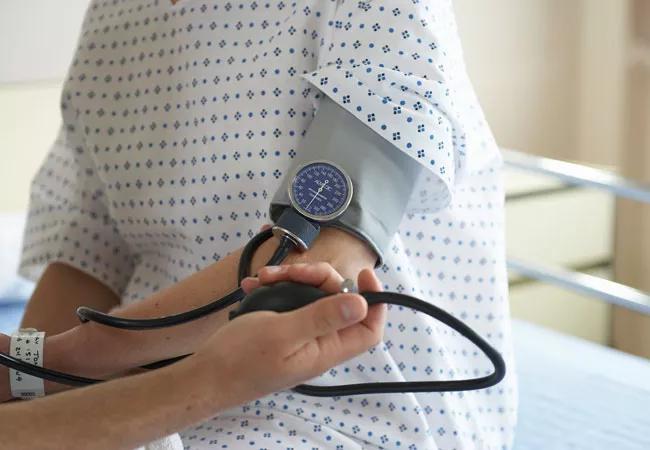Advertisement
Key findings and clinical takeaways

Findings from a new Cleveland Clinic-led study show that while high blood pressure is common among hospitalized patients, intensifying hypertensive treatment in the inpatient setting may do more harm than good. The study was published in JAMA-Internal Medicine.
Advertisement
Cleveland Clinic is a non-profit academic medical center. Advertising on our site helps support our mission. We do not endorse non-Cleveland Clinic products or services. Policy
Hypertension has traditionally been studied as a chronic, outpatient condition. Less understood, however, are the short-term effects of elevated blood pressure on patients’ health. Michael Rothberg, MD, MPH, Director of the Center for Value-Based Care Research at Cleveland Clinic, and research team set out to examine outcomes associated with the treatment of inpatient hypertension among non-cardiac adult patients.
In a retrospective review, the team analyzed electronic health record data from patients across ten Cleveland Clinic locations during 2017, with one year of follow-up. The study excluded patients with conditions associated with well-defined blood pressure management guidelines. Hypertension was defined as a systolic blood pressure ≥ 140 mm Hg.
Among patients (N = 22,834) hospitalized for non-cardiovascular diagnoses, the mean age was 65.6 years old; 43.1% were male, and 78% had at least one hypertensive episode during their admission. About 33% of these patients were treated, and only 9% of their hypertensive systolic blood pressures were treated.
After controlling for demographic and clinical variables, investigators compared the outcomes of treated patients with that of those in a propensity-matched control group. Their findings show that patients who received antihypertensive treatment were more likely to experience acute kidney injury (10.3% vs. 7.9%, p < 0.001) and myocardial injury (1.2% vs 0.6%, p = 0.003). They also looked to see whether patients with very high blood pressures might benefit from treatment, but there was no blood pressure interval in which treated patients had better outcomes than non-treated patients.
Advertisement
Intensification of antihypertensive regimen medication at discharge was also not associated with improved outcomes. Nine percent of the hypertensive patients were sent home with a new medication, but in the following year their blood pressures were no better controlled than patients whose regimens remained unchanged.
For both cohorts, inpatient stroke was extremely rare (0.1% of treated and 0.1% of untreated patients, p = 1).
Dr. Rothberg remarks that this investigation was a natural extension of an earlier study, also published in JAMA-Internal Medicine that compared outcomes of patients with high blood pressures who were sent to the emergency department with that of those who were treated in an ambulatory setting. The study shows that the ED cohort was associated with more hospitalizations, but not improved outcomes. Most of these patients still had uncontrolled hypertension six months later. This study is conceptually similar to this one, he says, although it’s not focused on an inpatient population.
The relatively low number of hypertensive patients who received treatment and who were given medication at discharge was surprising to Dr. Rothberg. However, he puts these findings in context, noting a paradigm shift among physicians about the treatment of inpatient hypertension is likely responsible. As the literature grows, the practice, too, has been changing. “Studies like this, and others like it, continue to accelerate that thinking,” he says.
Hypertension is a chronic disease with strong evidence-based guidelines for managing long-term care. Management takes place over months to years, and not in hours or in a day, stresses Dr. Rothberg. It’s not an emergency when a patient has blood pressure above 220 mm Hg and is asymptomatic.
In this situation, he explains, “You can wait and retake the patient’s blood pressure a few hours later, or if they’ve got a dose coming up, you could give them their next dose even if it’s a little early. But it’s not an emergency that warrants IV medication and dropping their blood pressure in the next 20 minutes.”
He continues, “Whether or not you’re convinced that the treatment is harmful, it’s unlikely that the treatment is going to be helpful. And when you look at the bigger picture, if we can remove just one thing from the equation that might be anxiety-inducing to patients and burdensome to clinical care teams — that’s a good thing.”
Advertisement
Advertisement

An updated review of risk factors, management and treatment considerations

Perserverance may depend on several specifics, including medication type, insurance coverage and medium-term weight loss

Study shows some surprising findings

Pinpointing factors associated with patient satisfaction

Contraindication for migraine without aura based on decades old data

Provides valuable data to guide public health and research priorities

Patients report better mood, less stress, more comfort

OMT may be right for some with Graves’ eye disease